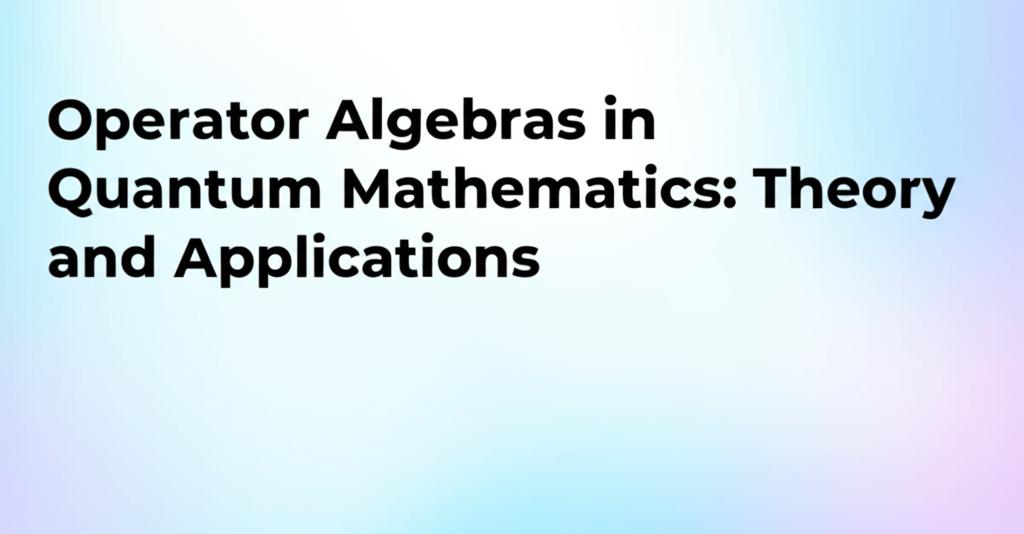Operator algebras, initially developed by John von Neumann to provide a rigorous mathematical framework for quantum mechanics, have evolved into a vibrant field of research with profound connections to various areas of mathematics and physics. This branch of functional analysis studies algebras of bounded linear operators on Hilbert spaces, primarily C-algebras and von Neumann algebras. These structures are fundamental to understanding the intricacies of quantum systems and have found diverse applications in quantum field theory (QFT), quantum statistical mechanics, and the rapidly advancing field of quantum information theory.
The interplay between operator algebras and quantum mechanics is foundational. Operator algebras provide the natural language for describing observables and states in quantum systems. In recent years, this relationship has deepened, particularly with the rise of quantum information science. Concepts central to quantum information, such as entanglement, quantum channels, non-locality, and quantum entropy, have been shown to have close ties to the theory of operator spaces, operator systems, and C-algebras. This cross-pollination has led to significant progress on complex problems in both disciplines.
A landmark achievement showcasing this synergy is the resolution of the Connes Embedding Problem, a long-standing question in operator algebras, using techniques from quantum information theory and quantum complexity. This development has spurred new research directions, further bridging these domains.
Key Theoretical Aspects and Recent Developments:- Classification of C-algebras: A significant ongoing effort in operator algebra theory is the classification of C-algebras. This involves creating a systematic understanding of these complex mathematical objects, much like a biologist classifies species. Success in classifying certain families of C-algebras has been achieved, but general classification remains a major challenge, with new methods from order theory being explored.
- Von Neumann Algebras in Quantum Field Theory and Quantum Gravity: Von Neumann algebras are crucial in algebraic QFT for modeling local observables. Recent research has highlighted their role in understanding entanglement entropy in QFT and in the context of quantum gravity, particularly in describing observables in black hole backgrounds where Type II von Neumann algebras naturally arise.
- Quantum Groups and Noncommutative Geometry: Quantum groups, which are generalizations of symmetry groups, play a vital role in understanding quantum integrable systems and have deep connections with operator algebras. Noncommutative geometry, pioneered by Alain Connes, utilizes operator algebras to extend geometric concepts to noncommutative spaces, finding applications in areas like the Standard Model of particle physics.
- Subfactor Theory: Originating from Jones' work, the theory of subfactors (special inclusions of von Neumann algebras) has had a broad impact on mathematical physics, including low-dimensional topology (e.g., the Jones polynomial) and the study of two-dimensional conformal field theories (CFTs). It also has profound connections to quantum statistical mechanics and topological phases of matter.
- Quantum Information Theory: Operator algebras are instrumental in analyzing quantum correlations, channel capacities, quantum game values, and zero-error quantum information. They provide a framework for understanding the limits of information processing in quantum systems and for developing new quantum algorithms and cryptographic protocols. The study of quantum graphs, which arise in quantum channel theory and quantum automorphism groups, is an active area of research.
- Quantum Computing: The mathematical framework of operator algebras underpins aspects of quantum computing. For instance, research into quantum error correction benefits from insights from operator algebras. The development of quantum algorithms for solving differential equations and problems in quantum simulation also draws on these mathematical tools.
- Quantum Statistical Mechanics: Operator algebras have a long history of interaction with quantum statistical mechanics, providing tools to describe equilibrium states (KMS states) and, more recently, non-equilibrium phenomena in quantum systems. This includes exploring entropy production and its relationship to relative entropy in non-equilibrium steady states.
- Condensed Matter Physics: Operator algebras, particularly through subfactor theory and CFT, contribute to the understanding of topological phases of matter, which are a major focus in contemporary condensed matter physics.
The interaction between operator algebras and quantum mathematics continues to be a fertile ground for discovery. Ongoing research focuses on resolving open problems like the Hyperlinearity Conjecture, which relates to the complexity of mathematical structures based on underlying symmetries, by leveraging quantum information approaches. The development of new mathematical tools for theoretical physics and the exploration of deeper connections between operator algebra theory, quantum computing, and quantum gravity remain key objectives. The ongoing classification program for C-algebras and the application of operator algebraic techniques to understand complex quantum phenomena promise further breakthroughs. Several upcoming workshops and conferences are dedicated to fostering collaboration and advancing research in these interconnected areas.

